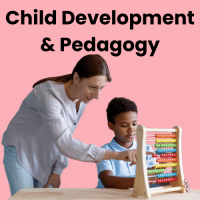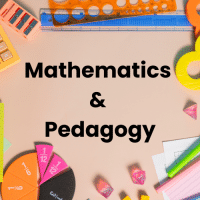CTET & State TET Exam > CTET & State TET Questions > Which one of the following teaching method is...
Start Learning for Free
Which one of the following teaching method is child centred method?
- a)Demonstration method
- b)Lecture method
- c)Lecture-cum-demonstration method
- d)Laboratory method
Correct answer is option 'D'. Can you explain this answer?
| FREE This question is part of | Download PDF Attempt this Test |
Most Upvoted Answer
Which one of the following teaching method is child centred method?a)D...
Child-Centered Teaching Method: Laboratory Method
In child-centered teaching methods, the focus is on the needs, interests, and abilities of the child. The child is actively involved in the learning process and encouraged to explore, inquire, and discover knowledge. Among the given options, the laboratory method aligns best with the child-centered approach.
The laboratory method involves hands-on activities and experiments that allow students to actively engage in the learning process. This method provides students with opportunities to explore concepts through practical experiences, promote critical thinking, and develop problem-solving skills. It encourages students to take ownership of their learning and fosters a deeper understanding of the subject matter.
Advantages of the Laboratory Method:
1. Active Learning: Students actively participate in experiments, allowing them to explore and discover concepts on their own. They engage in meaningful experiences that enhance their understanding and retention of information.
2. Practical Skills: Laboratory activities develop practical skills such as observation, measurement, data collection, analysis, and interpretation. These skills are essential for scientific inquiry and real-life applications.
3. Critical Thinking: By conducting experiments, students learn to think critically, analyze data, identify patterns, and draw conclusions. They develop problem-solving skills and become more independent learners.
4. Collaboration: Laboratory activities often involve group work, promoting collaboration and teamwork. Students learn to communicate, share ideas, and work together to achieve common goals.
5. Motivation and Engagement: Hands-on activities in the laboratory create a sense of curiosity, excitement, and motivation among students. They are more engaged in the learning process and develop a positive attitude towards the subject.
6. Application of Knowledge: Laboratory experiments provide opportunities for students to apply theoretical concepts to practical situations. This helps in bridging the gap between theory and application.
Conclusion:
The laboratory method, as a child-centered teaching method, promotes active learning, critical thinking, collaboration, and the practical application of knowledge. It empowers students to become independent learners and develops a deeper understanding of the subject matter. By engaging in hands-on activities and experiments, students are better able to connect with the content and develop important skills for their academic and personal growth.
In child-centered teaching methods, the focus is on the needs, interests, and abilities of the child. The child is actively involved in the learning process and encouraged to explore, inquire, and discover knowledge. Among the given options, the laboratory method aligns best with the child-centered approach.
The laboratory method involves hands-on activities and experiments that allow students to actively engage in the learning process. This method provides students with opportunities to explore concepts through practical experiences, promote critical thinking, and develop problem-solving skills. It encourages students to take ownership of their learning and fosters a deeper understanding of the subject matter.
Advantages of the Laboratory Method:
1. Active Learning: Students actively participate in experiments, allowing them to explore and discover concepts on their own. They engage in meaningful experiences that enhance their understanding and retention of information.
2. Practical Skills: Laboratory activities develop practical skills such as observation, measurement, data collection, analysis, and interpretation. These skills are essential for scientific inquiry and real-life applications.
3. Critical Thinking: By conducting experiments, students learn to think critically, analyze data, identify patterns, and draw conclusions. They develop problem-solving skills and become more independent learners.
4. Collaboration: Laboratory activities often involve group work, promoting collaboration and teamwork. Students learn to communicate, share ideas, and work together to achieve common goals.
5. Motivation and Engagement: Hands-on activities in the laboratory create a sense of curiosity, excitement, and motivation among students. They are more engaged in the learning process and develop a positive attitude towards the subject.
6. Application of Knowledge: Laboratory experiments provide opportunities for students to apply theoretical concepts to practical situations. This helps in bridging the gap between theory and application.
Conclusion:
The laboratory method, as a child-centered teaching method, promotes active learning, critical thinking, collaboration, and the practical application of knowledge. It empowers students to become independent learners and develops a deeper understanding of the subject matter. By engaging in hands-on activities and experiments, students are better able to connect with the content and develop important skills for their academic and personal growth.
Free Test
FREE
| Start Free Test |
Community Answer
Which one of the following teaching method is child centred method?a)D...
A teaching method is an orderly and logical arrangement of ideas based on a particular approach. It is a procedural illustration of systematic and clearly defined steps for accomplishing particular objectives.
Attention CTET & State TET Students!
To make sure you are not studying endlessly, EduRev has designed CTET & State TET study material, with Structured Courses, Videos, & Test Series. Plus get personalized analysis, doubt solving and improvement plans to achieve a great score in CTET & State TET.

|
Explore Courses for CTET & State TET exam
|

|
Similar CTET & State TET Doubts
Which one of the following teaching method is child centred method?a)Demonstration methodb)Lecture methodc)Lecture-cum-demonstration methodd)Laboratory methodCorrect answer is option 'D'. Can you explain this answer?
Question Description
Which one of the following teaching method is child centred method?a)Demonstration methodb)Lecture methodc)Lecture-cum-demonstration methodd)Laboratory methodCorrect answer is option 'D'. Can you explain this answer? for CTET & State TET 2024 is part of CTET & State TET preparation. The Question and answers have been prepared according to the CTET & State TET exam syllabus. Information about Which one of the following teaching method is child centred method?a)Demonstration methodb)Lecture methodc)Lecture-cum-demonstration methodd)Laboratory methodCorrect answer is option 'D'. Can you explain this answer? covers all topics & solutions for CTET & State TET 2024 Exam. Find important definitions, questions, meanings, examples, exercises and tests below for Which one of the following teaching method is child centred method?a)Demonstration methodb)Lecture methodc)Lecture-cum-demonstration methodd)Laboratory methodCorrect answer is option 'D'. Can you explain this answer?.
Which one of the following teaching method is child centred method?a)Demonstration methodb)Lecture methodc)Lecture-cum-demonstration methodd)Laboratory methodCorrect answer is option 'D'. Can you explain this answer? for CTET & State TET 2024 is part of CTET & State TET preparation. The Question and answers have been prepared according to the CTET & State TET exam syllabus. Information about Which one of the following teaching method is child centred method?a)Demonstration methodb)Lecture methodc)Lecture-cum-demonstration methodd)Laboratory methodCorrect answer is option 'D'. Can you explain this answer? covers all topics & solutions for CTET & State TET 2024 Exam. Find important definitions, questions, meanings, examples, exercises and tests below for Which one of the following teaching method is child centred method?a)Demonstration methodb)Lecture methodc)Lecture-cum-demonstration methodd)Laboratory methodCorrect answer is option 'D'. Can you explain this answer?.
Solutions for Which one of the following teaching method is child centred method?a)Demonstration methodb)Lecture methodc)Lecture-cum-demonstration methodd)Laboratory methodCorrect answer is option 'D'. Can you explain this answer? in English & in Hindi are available as part of our courses for CTET & State TET.
Download more important topics, notes, lectures and mock test series for CTET & State TET Exam by signing up for free.
Here you can find the meaning of Which one of the following teaching method is child centred method?a)Demonstration methodb)Lecture methodc)Lecture-cum-demonstration methodd)Laboratory methodCorrect answer is option 'D'. Can you explain this answer? defined & explained in the simplest way possible. Besides giving the explanation of
Which one of the following teaching method is child centred method?a)Demonstration methodb)Lecture methodc)Lecture-cum-demonstration methodd)Laboratory methodCorrect answer is option 'D'. Can you explain this answer?, a detailed solution for Which one of the following teaching method is child centred method?a)Demonstration methodb)Lecture methodc)Lecture-cum-demonstration methodd)Laboratory methodCorrect answer is option 'D'. Can you explain this answer? has been provided alongside types of Which one of the following teaching method is child centred method?a)Demonstration methodb)Lecture methodc)Lecture-cum-demonstration methodd)Laboratory methodCorrect answer is option 'D'. Can you explain this answer? theory, EduRev gives you an
ample number of questions to practice Which one of the following teaching method is child centred method?a)Demonstration methodb)Lecture methodc)Lecture-cum-demonstration methodd)Laboratory methodCorrect answer is option 'D'. Can you explain this answer? tests, examples and also practice CTET & State TET tests.

|
Explore Courses for CTET & State TET exam
|

|
Suggested Free Tests
Signup for Free!
Signup to see your scores go up within 7 days! Learn & Practice with 1000+ FREE Notes, Videos & Tests.
























